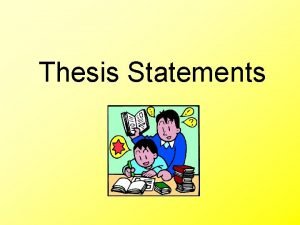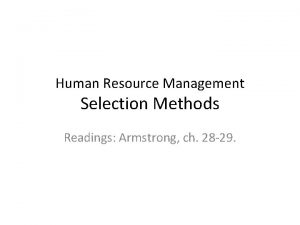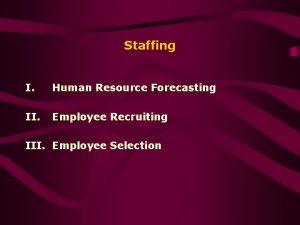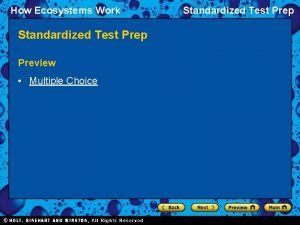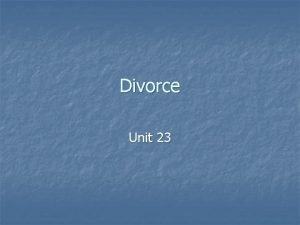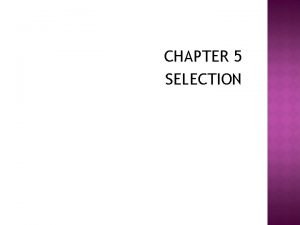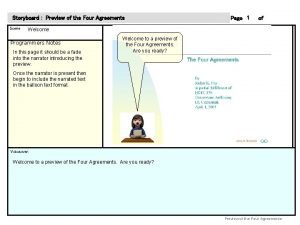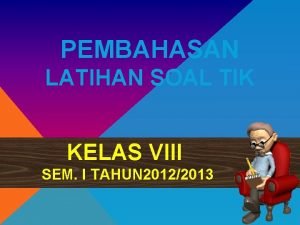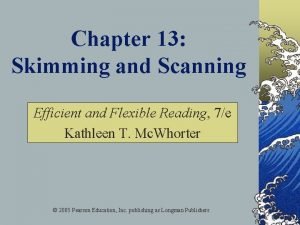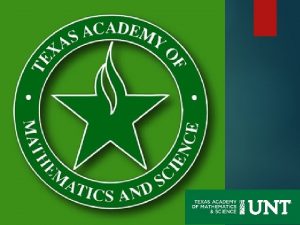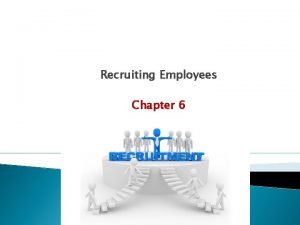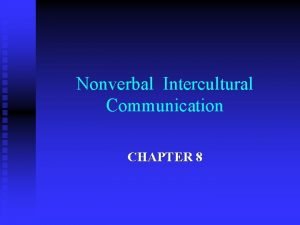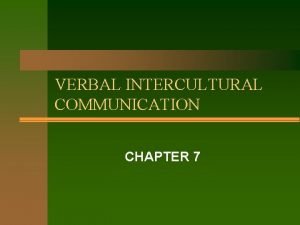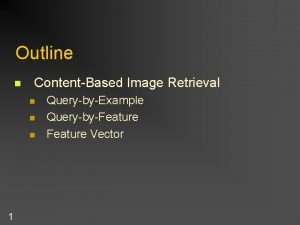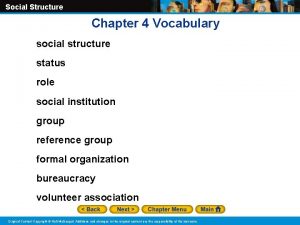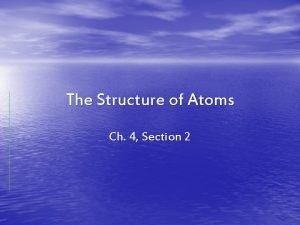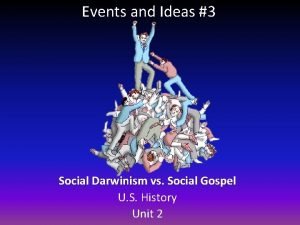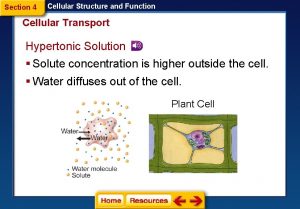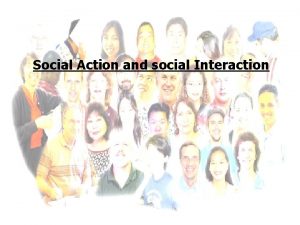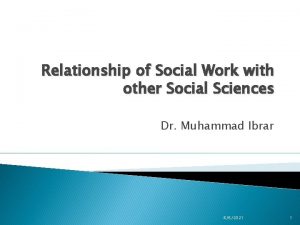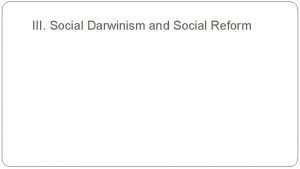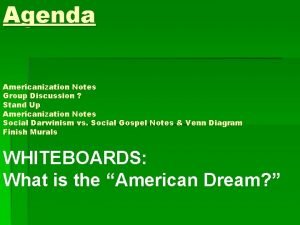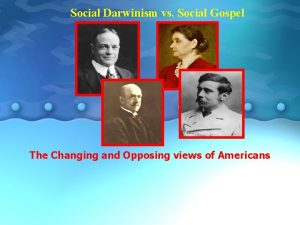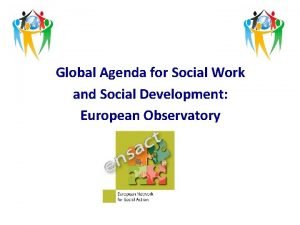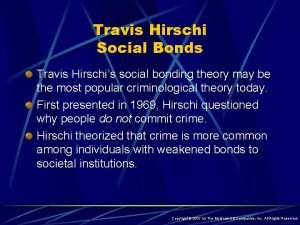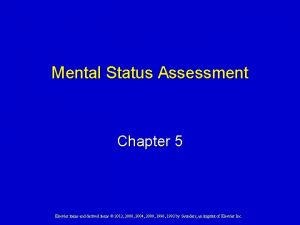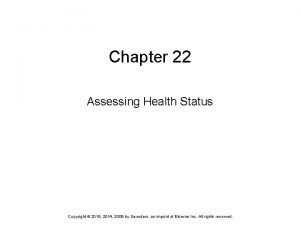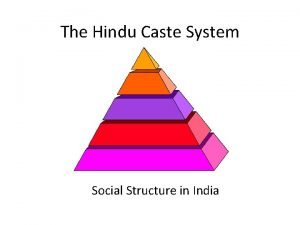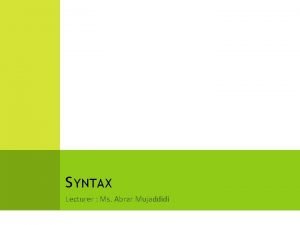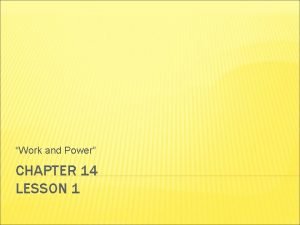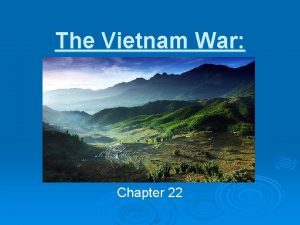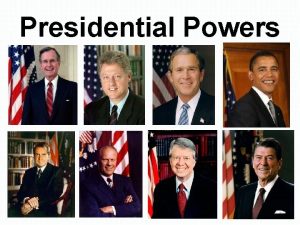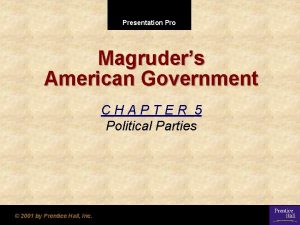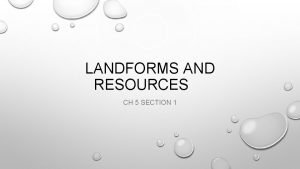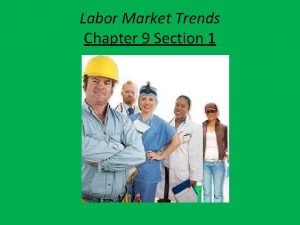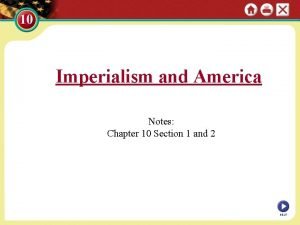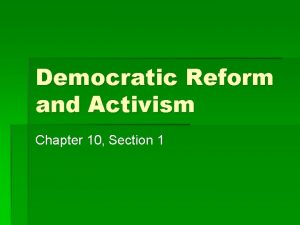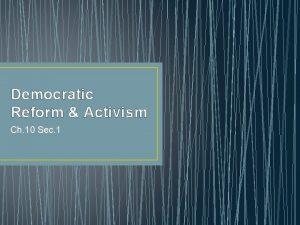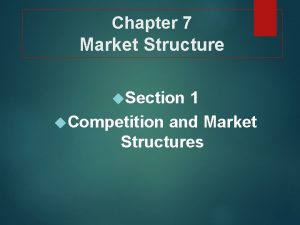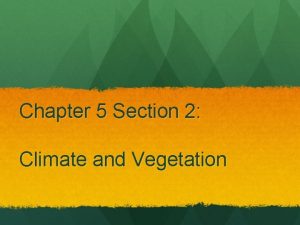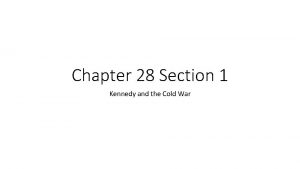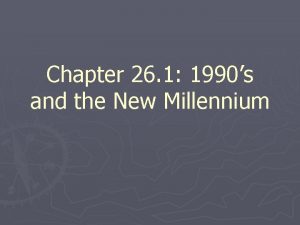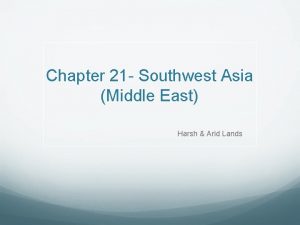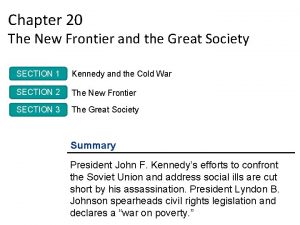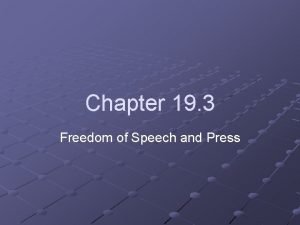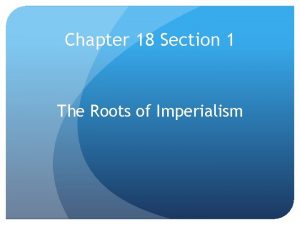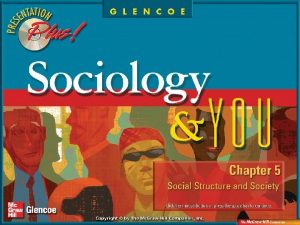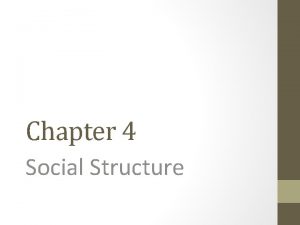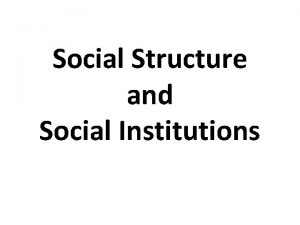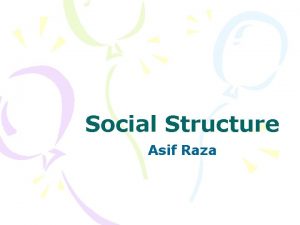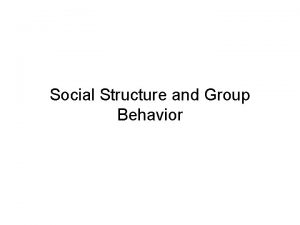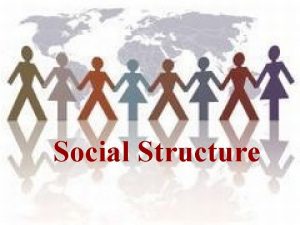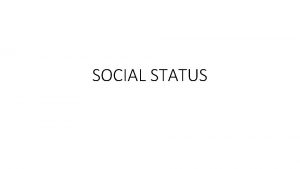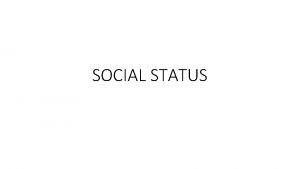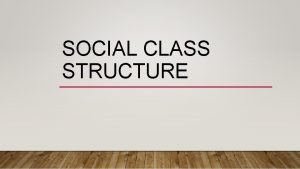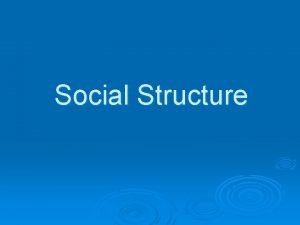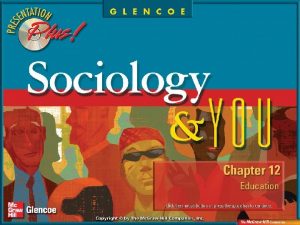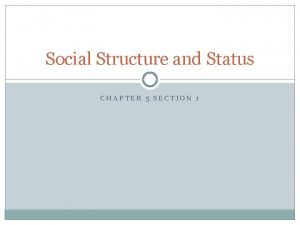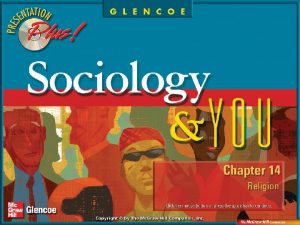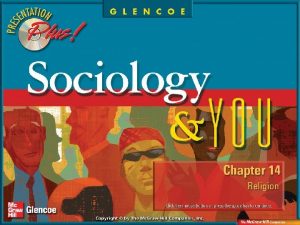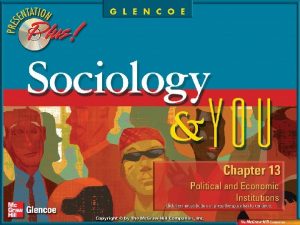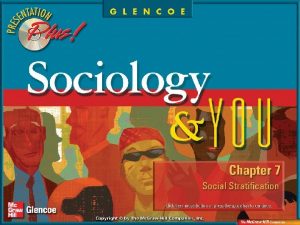Chapter Preview Section 1 Social Structure and Status








































































































- Slides: 104


Chapter Preview Section 1: Social Structure and Status Section 2: Social Structure and Roles Section 3: Preindustrial Societies Section 4: Industrial and Postindustrial Societies

Chapter Preview · Section 1 Social Structure and Status (pages 140– 145) The underlying pattern of social relationships in a group is called the social structure. Status is one very important element of social structure. Ascribed statuses are assigned at birth; achieved statuses are earned or chosen.

Chapter Preview · Section 2 Social Structure and Roles (pages 146– 152) People interact according to prescribed roles. These roles carry certain rights and obligations. Sometimes conflict or strain occurs when an individual has too many roles to play.

Chapter Preview · Section 3 Preindustrial Societies (pages 153– 158) The way a society provides for basic needs greatly affects its culture and social structure. Preindustrial societies include hunting and gathering, horticultural, pastoral, and agricultural societies.

Chapter Preview · Section 4 Industrial and Postindustrial Societies (pages 159– 164) The Industrial Revolution created a new type of society called an industrial society. Characteristics that distinguish this society from all earlier ones include the growth of large cities and a widespread dependence on machines and technology. Postindustrial society has a predominately white-collar labor force that is concentrated in service industries. Social instability has been linked to the transition from an industrial to a postindustrial society.


The underlying pattern of social relationships in a group is called the social structure. Status is one very important element of social structure. Ascribed statuses are assigned at birth; achieved statuses are earned or chosen.

• social structure • status • ascribed status • achieved status • status set • master status

Which is a way that people display their status in our society? A. Their home B. Their car C. Wearing a uniform D. All of the above A. B. C. D. A B C D

Social Structure Is All Around You • Social structure is the underlying patterns of relationships in a group.

Which is NOT an aspect of social structure? A. It involves groups B. It involves patterns C. It involves computers D. It involves relationships A. B. C. D. A B C D

Everyone Has Status • A status is a position a person occupies within a social structure. • An ascribed status is neither earned nor chosen; it is assigned to us.

Everyone Has Status (cont. ) • An achieved status is earned or chosen. • A status set is all of the statuses that a person occupies at any particular time. The Interrelationships of Social Statuses

Everyone Has Status (cont. ) • Master statuses can be achieved or ascribed; they significantly affect the likelihood of achieving other social statuses.

Which type of status would a doctor fall under? A. Master B. Status set C. Ascribed D. Achieved A. B. C. D. A B C D


People interact according to prescribed roles. These roles carry certain rights and obligations. Sometimes conflict or strain occurs when an individual has too many roles to play.

• role • right • obligation • role performance • social interaction • role conflict • role strain

Which role do identify with the most? A. Student B. Sibling C. Artist D. Athlete A. B. C. D. A B C D

Rights and Obligations • An expected behavior associated with a particular status is a role. • Rights are behaviors that individuals expect from others. • Obligations are behaviors that individuals are expected to perform toward others.

Statuses “in action” is another name for: A. Rights B. Roles C. Obligations D. Society A. B. C. D. A B C D

Role Performance and Social Interaction • Role performance is the actual conduct, or behavior, involved in carrying out (or performing) a role. • Social interaction is the process of influencing each other as people relate. The Links Between Culture and Social Structure

Role Performance and Social Interaction (cont. ) • Role performance is much like a play, but there are many differences: – Most real-life role performance occurs without planning. – Real-life performance is ad-libbed. – We choose our own cues and responses.

Which is an example of social interaction? A. Asking a stranger for directions B. Chatting with friends C. Playing sports D. All of the above A. B. C. D. A B C D

Role Conflict and Role Strain • Role conflict exists when the performance of a role in one status clashes with the performance of a role in another. • Role strain occurs when a person has trouble meeting the many roles connected with a single status.

Role Conflict and Role Strain (cont. ) • To deal with the conflict and strain we: – Set priorities – Segregate roles Illustrating Social Structure Concepts Unemployment Rates

How often does role strain and conflict affect your own life? A. Very often B. Sometimes C. Rarely D. Never A. B. C. D. A B C D


The way a society provides for basic needs greatly affects its culture and social structure. Preindustrial, and postindustrial societies meet basic needs in different ways. Preindustrial societies include hunting and gathering, horticulture, pastoral, and agricultural societies.

• society • hunting and gathering society • horticultural society • pastoral society • agricultural society

Which is an example of a preindustrial society? A. Hunting and gathering B. Pastoral C. Agricultural D. All of the above A. B. C. D. A B C D

Types of Society • A society is composed of people living within defined territorial borders who share a common culture.

Do you think our society today is becoming more global? A. Agree B. Disagree C. Not sure A. A B. B C. C

Hunting and Gathering Societies • Hunting and gathering society survives by hunting animals and gathering edible foods. Time Line of Societies

Hunting and Gathering Societies (cont. ) • Characteristics: – Nomadic – Small in population – Cooperation and sharing are key – No social class – Family is the only institution Time Line of Societies

The following are important in the hunting and gathering society EXCEPT A. Sharing B. Gathering food C. Thrift D. Moving from place to place A. B. C. D. A B C D

Horticultural Societies • A horticultural society solves the subsistence problem primarily through the growing of plants. Time Line of Societies

Horticultural Societies (cont. ) • Characteristics: – More permanent settlements – Multicommunity societies – Family more key – More complex division of labor – Trade possible Time Line of Societies

What do you think is the main difference between the horticultural society and the hunting and gathering society? A. The growing of plants B. Emphasis on family C. Permanent housing A. A B. B C. C

Pastoral Societies • In pastoral societies, food is obtained primarily by raising and taking care of animals. Time Line of Societies

Pastoral Societies (cont. ) • Characteristics: – Migration still needed, but with some permanent villages – Male dominated – More complex division of labor – Trade possible Time Line of Societies

Pastoral societies, food is primarily obtained by which method? A. Hunting B. Raising animals C. Growing crops D. Trade A. B. C. D. A B C D

Agricultural Societies • An agricultural society subsists by growing food, but with the use of plows and animals. Time Line of Societies

Agricultural Societies (cont. ) • Characteristics: – More food per unit of land due to the plow – Animals allow more people to engage in noneconomic activities – Cities built – Other occupations appear Time Line of Societies

Agricultural Societies (cont. ) – Political, economic, religious institutions appear – Government replaces the family group – King or emperor rules – Social classes – Economy based on trade Time Line of Societies

Agricultural Societies (cont. ) – Monetary system – Separation between religion and government Time Line of Societies

Which is NOT a true statement about the agricultural society? A. Distinct social class B. Monetary system used C. Wealth and power based on land ownership D. Nomadic society A. B. C. D. A B C D


The Industrial Revolution created a new type of society, called the industrial society. Characteristics that distinguish this society from all earlier ones include the growth of large cities and a wide-spread dependence on machines and technology. Postindustrial society has a predominately white-collar labor force that is concentrated in service industries. Social instability has been linked to the transition from an industrial to a postindustrial society.

• industrial society • mechanical solidarity • mechanization • organic solidarity • urbanization • postindustrial society • gemeinschaft • gesellschaft • social solidarity

Which technology do you think has made the biggest impact on our society? A. Personal computers B. Assembly lines C. Robots A. A B. B C. C

Basic Features of Industrial Societies • The industrial society is one that is dependent upon science and technology to produce its basic goods and services.

Basic Features of Industrial Societies (cont. ) • When societies shift from agricultural to industrial, some of the structural changes are: – A loss of simplicity and a gain of scientific knowledge – Animal and human labor is replaced by machines (mechanization) Agricultural Employment

Basic Features of Industrial Societies (cont. ) – Urbanization—the movement from the country to the city – Families function differently

Which of the following is a way that the family structure changed once an industrial society emerged? A. Women became more subordinate to their husbands. B. Family unity became less important. C. Education was taught at home. A. A B. B C. C

A Conversation with Two Sociologists • Tonnies’s view—two types of society: – Gemeinschaft = community; a society based on tradition, kinship, and intimate social relationships. – Gesellschaft = industrial society; weak family ties, competition, and less personal social relationships.

A Conversation with Two Sociologists (cont. ) • Durkheim’s view: – Social solidarity is the degree to which a society is unified or can hold itself together in the face of obstacles.

A Conversation with Two Sociologists (cont. ) • Two types of society that depend on solidarity: – Mechanical solidarity applies when members of a society hold the same beliefs, values, and norms; they tend to conform and depend on tradition and family to fulfill their needs. – Organic solidarity applies when members of an industrial society depend on a variety of people to fulfill their needs.

The following are characteristics of mechanical solidarity EXCEPT A. Group placed above the individual B. Pressure for conformity C. Needs filled by a variety of people D. Tradition and family important A. A B. B C. C D. D

Major Features of Postindustrial Society • In a postindustrial society, the economic emphasis is on providing services and information rather than on producing goods through basic manufacturing.

Major Features of Postindustrial Society (cont. ) • Five features of this society, according to Daniel Bell: – For the first time, the majority of the labor force are employed in services rather than in agriculture or manufacturing. – White-collar employment replaces much blue-collar work.

Major Features of Postindustrial Society (cont. ) – Technical knowledge is the key organizing feature in the postindustrial society. – Technological change is planned and assessed. – Computer modeling is relied upon in all areas.

What was the major economic emphasis placed on during the postindustrial society? A. Providing services B. Agriculture C. Raising animals D. All of the above A. A B. B C. C D. D

Social Instability in Postindustrial Society • Historian Francis Fukuyama believes that the transition to a service economy has increased social instability in nations undergoing this change. • However, he sees current indications of a return to social stability because humans find it difficult to live without values and norms.

Do you agree with Fukuyama’s observations? A. Strongly agree B. Somewhat agree C. Disagree D. Not sure A. A B. B C. C D. D


The Interrelationships of Social Statuses

The Links Between Culture and Social Structure


Time Line of Societies

Time Line of Societies

Unemployment Rates Source: U. S. Department of Labor, Bureau of Labor Statistics, 2005.

Agricultural Employment Source: U. S. Central Intelligence Agency, The World Factbook, 2005.


social structure the underlying patterns of relationships in a group

status a position a person occupies within a social structure

ascribed status a position that is neither earned nor chosen but assigned

achieved status a position that is earned or chosen

status set all of the statuses that a person occupies at any particular time

master status a person that strongly affects most other aspects of a person’s life

role an expected behavior associated with a particular status

right a behavior that individuals can expect from others

obligation a behavior that individuals are expected to perform toward others

role performance the actual behavior of an individual in a role

social interaction the process of influencing each other as people relate

role conflict condition in which the performance of a role in one status interferes with the performance of a role in another status

role strain condition in which the roles of a single status are inconsistent or conflicting

society people living within defined territorial borders and sharing a common culture

hunting and gathering society a society that survives by hunting animals and gathering edible plants

horticultural society a society that survives primarily through the growing of plants

pastoral society a society in which food is obtained primarily by raising and taking care of animals

agricultural society a society that uses plows and draft animals in growing food

industrial society a society that depends on science and technology to produce its basic goods and services

mechanization the process of replacing animal and human power with machine power

urbanization the shifting of population from farms and villages to large cities

gemeinschaft pre-industrial society based on tradition, kinship, and close social ties

gesellschaft industrial society characterized by weak family ties, competition, and impersonal social relationships

social solidarity the degree to which a society is unified

mechanical solidarity a type of social unity achieved by people doing the same type of work and holding similar values

organic solidarity a type of social unity in which members’ interdependence is based on specialized functions and statuses

postindustrial society a society in which the economic emphasis is on providing services and information

To use this Presentation Plus! product: Click the Forward button to go to the next slide. Click the Previous button to return to the previous slide. Click the Home button to return to the Chapter Menu. Click the Transparency button to access the transparencies that are relevant to this chapter. Click the Return button in a feature to return to the main presentation. Click the Sociology Online button to access online textbook features. Click the Exit button or press the Escape key [Esc] to end the chapter slide show. Click the Help button to access this screen. Links to Presentation Plus! features such as the Figures, Time Lines, Snapshot of America, World View and others are located at the bottom of relevant screens.

 3-point thesis statement examples
3-point thesis statement examples Summary thesis statement
Summary thesis statement Thesis and preview statement example
Thesis and preview statement example Classic trio' of selection techniques
Classic trio' of selection techniques Review and preview
Review and preview Benefits of hr forecasting
Benefits of hr forecasting Test prep preview
Test prep preview Test prep preview
Test prep preview Test prep preview
Test prep preview Test prep preview
Test prep preview Sccm technical preview
Sccm technical preview Startling statement introduction examples
Startling statement introduction examples Test prep preview
Test prep preview Nnn preview
Nnn preview The selection preview
The selection preview Test prep preview
Test prep preview The four agreements preview
The four agreements preview Test prep preview
Test prep preview Line between pada perintah column digunakan untuk membuat
Line between pada perintah column digunakan untuk membuat Test prep preview
Test prep preview How to skim effectively
How to skim effectively 1984 book preview
1984 book preview Yandex.ru video
Yandex.ru video Nút lệnh print preview nằm ở đâu
Nút lệnh print preview nằm ở đâu What is tams
What is tams Disadvantages of realistic job preview
Disadvantages of realistic job preview Multi-channeled definition in communication
Multi-channeled definition in communication Preview speech
Preview speech Preview of main points
Preview of main points Nnn image preview
Nnn image preview Fungsi movie task pane
Fungsi movie task pane Social structure guided reading section 4
Social structure guided reading section 4 Social thinking and social influence
Social thinking and social influence Social thinking social influence social relations
Social thinking social influence social relations Chapter 7 cell structure and function section review 7-2
Chapter 7 cell structure and function section review 7-2 Register (sociolinguistics)
Register (sociolinguistics) Chapter 10 meiosis 1 and meiosis 2
Chapter 10 meiosis 1 and meiosis 2 Chapter 4 section 2 the structure of atoms answer key
Chapter 4 section 2 the structure of atoms answer key Social darwinism vs social gospel
Social darwinism vs social gospel Difference between half section and full section
Difference between half section and full section Section 2 describing energy worksheet answers
Section 2 describing energy worksheet answers Guided reading activity deviance and social control
Guided reading activity deviance and social control Section 4 review physical science
Section 4 review physical science Section 24-1 viral structure and replication
Section 24-1 viral structure and replication Section 4 cellular transport
Section 4 cellular transport Difference between social action and social interaction pdf
Difference between social action and social interaction pdf Relationship between political science and social work
Relationship between political science and social work Social thinking and social influence
Social thinking and social influence What was reform darwinism
What was reform darwinism Social darwinism and social gospel venn diagram
Social darwinism and social gospel venn diagram Social gospel vs social darwinism
Social gospel vs social darwinism Global agenda for social work and social development
Global agenda for social work and social development Travis hirschi's social bond theory
Travis hirschi's social bond theory Social thinking theory
Social thinking theory Jarvis chapter 5 mental status assessment
Jarvis chapter 5 mental status assessment Assessing health status chapter 22
Assessing health status chapter 22 India powerful caste
India powerful caste Lexical ambiguity examples
Lexical ambiguity examples Surface structure and deep structure
Surface structure and deep structure S s' 's grammar
S s' 's grammar Static data structure
Static data structure Surface structure
Surface structure Hidden lines are not generally omitted in a sectional view
Hidden lines are not generally omitted in a sectional view Section
Section Chapter 10 section 2 central america and the caribbean
Chapter 10 section 2 central america and the caribbean Unit 14 lesson 1 drivers ed
Unit 14 lesson 1 drivers ed Acdc copyright
Acdc copyright Chapter 28 section 4 turmoil and change in mexico
Chapter 28 section 4 turmoil and change in mexico Chapter 22 section 5 the end of the war and its legacy
Chapter 22 section 5 the end of the war and its legacy Chapter 24 the land where continents collided
Chapter 24 the land where continents collided Chapter 11 section 2 stream and river deposits answer key
Chapter 11 section 2 stream and river deposits answer key Chapter 21 section 1 landforms and resources
Chapter 21 section 1 landforms and resources Chapter 14 section 3 diplomatic and military powers
Chapter 14 section 3 diplomatic and military powers Chapter 5 section 1 parties and what they do
Chapter 5 section 1 parties and what they do Chapter 11 section 3 motion and force answer key
Chapter 11 section 3 motion and force answer key Chapter 14 review acids and bases
Chapter 14 review acids and bases Chapter 5 section 1 landforms and resources answer key
Chapter 5 section 1 landforms and resources answer key Section 1 guided reading and review labor market trends
Section 1 guided reading and review labor market trends Chapter 10 section 1 imperialism and america
Chapter 10 section 1 imperialism and america Chapter 6 section 2 supply and demand in everyday life
Chapter 6 section 2 supply and demand in everyday life Chapter 17 domains and kingdoms answer key
Chapter 17 domains and kingdoms answer key Chapter 10 section 1 democratic reform and activism
Chapter 10 section 1 democratic reform and activism Chapter 10 section 1 democratic reform and activism
Chapter 10 section 1 democratic reform and activism Chapter 8 review chemical equations and reactions
Chapter 8 review chemical equations and reactions Lesson quiz 9-2 labor and wages
Lesson quiz 9-2 labor and wages Chapter 8 section 1 chemical equations and reactions
Chapter 8 section 1 chemical equations and reactions Chapter 8 section 1 what are earthquakes
Chapter 8 section 1 what are earthquakes Chapter 7 lesson 1 competition and market structures
Chapter 7 lesson 1 competition and market structures Chapter 5 section 2 climate and vegetation
Chapter 5 section 2 climate and vegetation Section quiz chapter28 kennedy and the cold war
Section quiz chapter28 kennedy and the cold war Chapter 27 physical geography of east asia
Chapter 27 physical geography of east asia General characteristics of arthropods
General characteristics of arthropods Chapter 26 section 1 the 1990s and the new millennium
Chapter 26 section 1 the 1990s and the new millennium Chapter 25 section 3 nepal and bhutan
Chapter 25 section 3 nepal and bhutan Chapter 24 introduction to animals worksheet answers
Chapter 24 introduction to animals worksheet answers Chapter 21 section 2 climate and vegetation
Chapter 21 section 2 climate and vegetation Chapter 21 section 1 plant evolution and adaptations
Chapter 21 section 1 plant evolution and adaptations Chapter 20 section 1 kennedy and the cold war
Chapter 20 section 1 kennedy and the cold war Chapter 2 principles of ecology
Chapter 2 principles of ecology Principles of ecology chapter 2 section 1 answer key
Principles of ecology chapter 2 section 1 answer key Principles of ecology chapter 2
Principles of ecology chapter 2 Chapter 2 section 1 organisms and their relationships
Chapter 2 section 1 organisms and their relationships Chapter 19 section 3 freedom of speech and press
Chapter 19 section 3 freedom of speech and press Roots of imperialism
Roots of imperialism Chapter 17 section 1 electric charge and force answer key
Chapter 17 section 1 electric charge and force answer key

